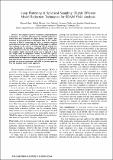Loop flattening & spherical sampling: Highly efficient model reduction techniques for SRAM yield analysis
Author(s)
Qazi, Masood; Tikeka, Mehul; Dolecek, Lara; Shah, Devavrat; Chandrakasan, Anantha P.
DownloadShah_Loop flattening.pdf (600.3Kb)
PUBLISHER_POLICY
Publisher Policy
Article is made available in accordance with the publisher's policy and may be subject to US copyright law. Please refer to the publisher's site for terms of use.
Terms of use
Metadata
Show full item recordAbstract
The impact of process variation in deep-submicron technologies is especially pronounced for SRAM architectures which must meet demands for higher density and higher performance at increased levels of integration. Due to the complex structure of SRAM, estimating the effect of process variation accurately has become very challenging. In this paper, we address this challenge in the context of estimating SRAM timing variation. Specifically, we introduce a method called loop flattening that demonstrates how the evaluation of the timing statistics in the complex, highly structured circuit can be reduced to that of a single chain of component circuits. To then very quickly evaluate the timing delay of a single chain, we employ a statistical method based on importance sampling augmented with targeted, high-dimensional, spherical sampling. Overall, our methodology provides an accurate estimation with 650X or greater speed-up over the nominal Monte Carlo approach.
Date issued
2010-04Department
Massachusetts Institute of Technology. Department of Electrical Engineering and Computer Science; Massachusetts Institute of Technology. Microsystems Technology LaboratoriesJournal
Design, Automation & Test in Europe Conference & Exhibition (DATE), 2010
Publisher
Institute of Electrical and Electronics Engineers
Citation
Qazi, M. et al. “Loop Flattening & Spherical Sampling: Highly Efficient Model Reduction Techniques for SRAM Yield Analysis.” Design, Automation & Test in Europe Conference & Exhibition (DATE), 2010 : 801-806. © 2010 IEEE.
Version: Final published version
ISBN
978-1-4244-7054-9
ISSN
1530-1591
INSPEC Accession Number: 11283197